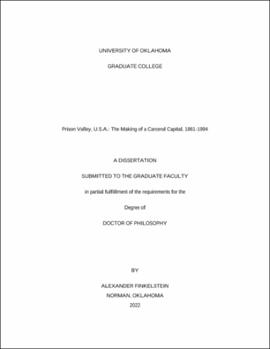| dc.description.abstract | The history of incarceration in Colorado from the birth of the territory in the 1860s through the 1990s is a history of continuity. Coloradans invoked the criminal legal system as a symbol of the state’s legitimate, effective governing powers and to define freedom as a product of race and class. The heart of Colorado’s prison system lies in Fremont County, where 20% of its residents are captive in the county’s nine state and four federal prisons. The county’s economy, culture, and politics revolve around the practice and idea of incarceration. Since Fremont County’s leaders pursued its first prison in the 1860s, local stakeholders have sought out and fought for carceral infrastructure. The history of incarceration in Colorado demonstrates the continuous presence of convict leasing, Jim Crow, and mass incarceration. Fremont County displays such recent developments as part of a longer, sustained history of carceral development in the United States, showing the punitive orientation that long undergirded America’s political and economic systems.
The persistent notion that freedom requires unfreedom justified carceral development as a social welfare solution serving both racialized criminalized communities and economically depressed spaces. Throughout this long history, the carceral state’s fundamental logics remained the same: that incarceration was a positive good that protected the free world and supported prison communities; and second, incarcerated people must provide labor for the state to offset the costs of incarceration and make the institution self-sufficient.
Despite the continuities in logics and practices, to be sure, the politics and processes of incarceration changed over time, especially as incarcerated people challenged the carceral state in new ways. Protest against the carceral state has been one of its persistent features. Incarcerated people and their allies protested in sanctioned and unsanctioned ways. Sanctioned protests, such as through the courts, regenerated the carceral state’s legitimacy by proving that it could reform itself without external oversight. Unsanctioned protests, such as work stoppages and escapes, provoked the state to develop new modes and architectures of incarceration.
In the 1860s, Fremont County and Colorado Territory leaders pursued a prison to prove to the country that they deserved statehood. An effective criminal legal system, they argued, demonstrated effective governance that protected its citizens. Over the state’s next 150 years, the notion that the state’s authority could be built and regenerated in strong criminal legal system that evolved continuously persisted. Colorado and the United States continued to expand its prison infrastructure—a women’s facility in 1935, a medium- and maximum-security prison in the 1950s, three new state prisons in the 1960s, a new Colorado prison industries program in the 1970s, four new state prisons in the 1980s, four federal prisons in the 1990s, and two new state prisons in the 1990s. This sustained carceral development represents a society dependent on punishment. Prisons, exemplified by those in Colorado, are a key to a society convinced that freedom for some requires the unfreedom of others. | en_US |

